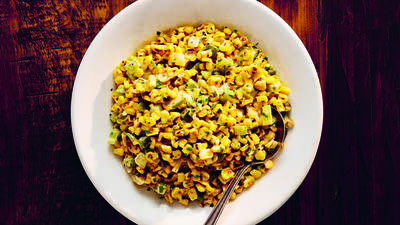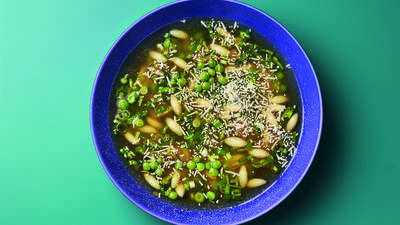
Foam is a lot more than just the meringue on your pie, according to Sidney Perkowitz, author of Universal Foam.
Lynne Rossetto Kasper: You're a physicist. I understand that you're an expert on the optical properties of matter?
Sidney Perkowitz: That's correct.
LRK: What's a nice physicist like you doing staring into a cup of cappuccino and writing about foam?
SP: It's not what physicists are usually pictured as doing, but we have a warrant to look at anything that interests us in the physical world. Foam sure is interesting. That's my excuse.
LRK: What's so compelling about foam?
SP: From the scientific side, commonplace as it is and ordinary as it seems, it really has unanswered questions lingering in it. From the human side, it's simply that it's fun. It seems to add a lot of pleasure to life in different ways.
LRK: How does a physicist define foam?
SP: The definition really is pretty simple. If I give you a pint of liquid or maybe a chunk of matter and in that liquid or that matter I mix in some bubbles of gas, I've given you a foam.
LRK: That can be a plastic like Styrofoam?
SP: Absolutely. That's a solid foam.
LRK: And that never dies, from what I understand. Styrofoam will be here millions of years from now, or tens of thousands of years?
SP: It turned out to be stronger than steel. If you put it in a landfill, it never goes away.
LRK: Then there's the foam on my cappuccino that disappears.
SP: That's the opposite extreme of foam. That's a liquid foam, a very tenuous thing. Yet that's part of its attraction, I think, that it's so fragile.
LRK: What's happening, from your point of view, when I look at my cup of espresso, my black coffee, with what the Italians call the "crema" on top, that lovely, sort of coffee-colored foam on top? What am I actually looking at from a scientist's point of view?
SP: I can tell you the geometry of what you're looking at, but actually explaining how the crema forms has not yet been fully understood. Isn't that amazing? But what you're looking at are bubbles of air mixed with the water that was in the coffee with some additional compounds that make the bubbles sturdy enough to last for a while. In other words, a classical foam.
LRK: What about some other edible foams?
SP: When I started to think about it, I was really amazed and enthralled to find how many examples there are. Beer is obvious. Everyone loves the head on a beer. Bread is a little less obvious, but it's fair to think of that as a solid foam. You start with something semi-liquid when you make bread dough, you bake it and you end up with a solid foam. Other foams are souffles and meringues. We can even think of some more than that, too.
LRK: Going back to bread, I don't think most of us ever think of bread as foam. What's actually happening there?
SP: It was a revelation to me, too. You're mixing together flour and the other ingredients with water to make something semi-liquid. Then you put in something to raise the bread, to leaven the bread, typically yeast, although there are other ways to do that. As the yeast interacts with the other compounds, it releases gas, carbon dioxide. That gas makes bubbles. Then, as the bread solidifies in the oven, those bubbles get frozen into place. Again you have classical foam: material full of gas bubbles. That's a foam.
LRK: What makes one foam stronger than another? For instance, if I let my egg whites just sit there, they're eventually going to go flat. But there are other foams that just sort of sit there. What is the difference?
SP: It comes down to whatever the additional compound is in your mixture that is making the bubble walls sturdy. Some bubble walls -- for instance, those made with what you find in egg white -- are especially sturdy. Meringue can do very well if you take good care of it. Others are not so sturdy. Soap suds bubble walls are not very strong. Soap suds don't last very long at all. It's the strength or the robustness of the wall that makes the gas bubble.
LRK: How much time have you actually spent studying these things?
SP: I've been thinking about foam for three years or more. In my case, it really did start from drinking cappuccino. That expanded in a scientific direction. I thought about the science of foam, but then I came back and saw how much foam there was in food. That excited my interest in a whole different direction.
LRK: The name of your book is Universal Foam: From Cappuccino to the Cosmos. I think I have some sense about foam and food, but now you have to make the leap for me. What about the cosmos?
SP: I'd love to do that because that's one of the most fascinating manifestations of foam. Actually, if I say cosmos, I mean every level you can think of, from smaller than an electron to the size of many, many galaxies.
Let's start at the big end. At the big end, the cosmic sense of foam is this: If you look at how all the galaxies in the universe are arranged, they're arranged as if they're made up of surfaces of enormous, enormous soap bubbles, trillions and trillions and trillions of miles across, bubbles sitting cheek by jowl. It really would be fair to say that, on the big scale, the universe looks like the head on a beer or the head on a cappuccino.
LRK: That's what the universe looks like?
SP: I don't want to offend anyone. We all have our opinions of the universe, but let's say one good geometrical image is the head on a beer. That's absolutely correct.
LRK: Now take me to the other end of the spectrum.
SP: Way down at the smallest scale, you can think of a proton, or an electron, or a quark, or something even smaller than that. If we had powerful enough microscopes, you would see that down at that level, space, time, the stuff that surrounds us, the three dimensions of length, width and thickness, and the flow of time behave as if they're a foam. They change rapidly, radically and randomly, as if you had bubbles of space and time collapsing, distorting, going away, being created. It's a very fascinating image.
LRK: You know what comes to mind as you say that? I'm thinking of standing at the seashore and seeing when waves come crashing in on the sand. When they wash up, they leave behind these arcs of foam on the sand.
SP: It's a lovely image to illuminate what the universe looks like way down at the smallest scale. I'm talking about space and time forming, changing and bubbling without ever stopping. There's always a dynamic action going on. Your image of the ocean foam, the sea foam, is the same. It never stops changing, whether it's on the top of the wave or just collapsing as it lies on the beach.
By the way, let me add that sea foam is more than just a metaphor for the things I'm talking about. It, itself, has a function in our world. The temperature of the world and the climate depend on how much sunlight the world absorbs. Because ocean foam is white and it reflects more sunlight than ordinary seawater, it actually affects the climate and the meteorology of the whole world. That's been figured out only quite recently. It was quite a revelation to the scientific community.
LRK: Something that you think of as just being sort of a byproduct -- a wave goes plunk -- actually has a reason for being. It's part of the order of things in our world.
SP: It's part of the order of things in our world. We're learning that there are really subtle connections between the ocean, the atmosphere, the land and life itself. Foam, it seems, plays a role in that, as a chapter in that story.
Before you go...
Each week, The Splendid Table brings you stories that expand your world view, inspire you to try something new, and show how food connects us all. We rely on your generous support. For as little as $5 a month, you can have a lasting impact on The Splendid Table. And, when you donate, you’ll join a community of like-minded individuals who love good food, good conversation, and kitchen companionship. Show your love for The Splendid Table with a gift today.
Thank you for your support.
Donate today for as little as $5.00 a month. Your gift only takes a few minutes and has a lasting impact on The Splendid Table and you'll be welcomed into The Splendid Table Co-op.




